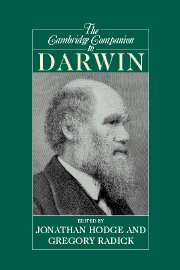16 - Ethical expressions
from PART IV - WAYS FORWARD
Published online by Cambridge University Press: 28 May 2006
Summary
DARWINISM AND THE MANIFEST IMAGE OF HUMANKIND
A major task for philosophy is to adjudicate conflicts between our ordinary way of understanding persons and the world - what Wilfrid Sellars called the 'manifest image' - and scientific accounts of persons and the world - the 'scientific image'. Sometimes, of course, it is possible to blend the two images so as to produce a genuinely stereoscopic or synthetic picture. But this is not always possible. In the case of Darwin's theory of natural selection, we seem to have a scientific theory that cannot be comfortably assimilated into the extant manifest image by adding, in Sellars' phrase, a 'needle point of detail' to that image.
As traditionally understood, we humans are made in God’s image and sit beneath God and the angels and above the animals on the ‘Great Chain of Being’. There is a tripartite ontology of Pure Spirit(s) (God and angels), pure matter (rocks, plants and animals), and dualistic beings who, while on earth, partake of both the immaterial realm and the material realm (us). We humans know the material realm through our senses and reason, and the immaterial realm – theological and moral truths in particular – through illumination, grace or other non-empirical and nonrational or arational means. God sets out the moral law, and if we obey it, thereby using our free will properly, we will gain eternal salvation.
Nothing in this metaphysics, epistemology and ethics seems to square with the theory of natural selection. On this theory, no divine, intelligent designer is needed to explain the existence of humans or any other type of organic life. Moreover, as animals, descended from other animals, we humans possess no mysterious epistemic powers to detect what is true or what is good. The idea that morality has a divine origin and justification loses its force. The prospects for personal immortality seem nil. The manifest image of humankind thus takes a major hit at the hands of Darwin2019s theory, and it is not clear how to maintain sensibly the central components of that image.
- Type
- Chapter
- Information
- The Cambridge Companion to Darwin , pp. 377 - 398Publisher: Cambridge University PressPrint publication year: 2003
- 1
- Cited by



